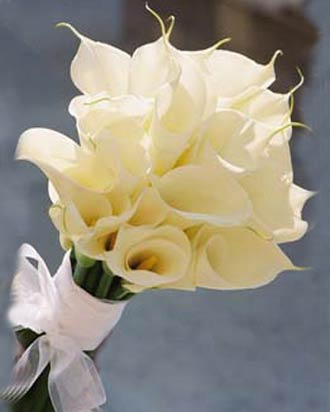Calla Lily Bridal Bouquet Biography
Source(google.com.pk)Calla (Richardia) - This name has been accepted by botanists for the last three-quarters of a century, although it is not yet generally used by gardeners. (Also called Zantedeschia aethiopica.)
chia seeds sssuper sale export prices, small and large quantities DIRECTLY from S America www.oilseeds-bolivia.com
The genus consists now of various species. They all have a perennial tuberous root-stock, not unlike that of Caladium, from which spring the annual leaves and scapes, the former with folding stalks, which form a kind of stem, bearing sagittate leaves, the latter erect, stout, and bearing a large spathe. There is a noteworthy difference between R. aethiopica and the others, the former having a rhizome and never naturally dying down.
Calla Lily Cultivation
These hardy perennials are ideal for zones seven to ten and do not even have to have their bulbs lifted for winter in gardening zones nine and ten. Other zones should dig the roots after a frost. Available in shades ranging from white and soft pink to yellow and vibrant red, they may grow to nearly two feet in height. They are long blooming flowers and in zones eight to ten can bloom year round.
They like rich, well-drained soil and can be cultivated indoors as houseplants.
Lily of the Nile (Richardia Aethiopica) - Introduced into Europe from S. Africa in 1687. It is emphatically a Cape plant, and is not found within 1,000 miles or so of the Nile, although it is commonly known as the Lily of the Nile. In some parts of this country, for instance Cornwall, it has become naturalised in shallow water, spreading and flowering with the same freedom as in the ditches and swamps of the Cape.
These are also sometimes called Easter Lilies.
All species are endemic to southern Africa. Z. aethiopica grows naturally in marshy areas and is only deciduous when water becomes scarce. It grows continuously when watered and fed regularly and can survive periods of minor frosts. Z. aethiopica is a very strong and sturdy plant, being able to grow in many soils and habitats, multiplying by rhizome-offsets; it is naturalised and regarded as a weed throughout much of the world. Z. odorata is a rare species, resembling Z. aethiopica, but deciduous and smelling like freesia, endemic to a few localities in South Africa. Z. albomaculata is a widespread and variable species, growing from South Africa north to Kenya, varying in shades of white to cream and pink to orange-shades. Z. elliotiana is known from horticultural sources only and is probably of hybrid origin. Z. jucunda and Z. pentlandii are rare species with beautiful large yellow showy flowers. Z. rehmannii is a pink-flowered species with sword shaped leaves.
Zantedeschia cultivar
All Zantedeschias produce large, showy flowers spathes and are often grown both as ornamental plants and for cut flowers. Zantedeschia are hardy plants, but some are more winter-hardy than others. The white Zantedeschia aethiopica and some of its relatives can survive at minimum winter temperatures below -23 °C (USDA Zone 6) and many others can be grown in even warmer areas where all the ground does not freeze (USDA Zone 7). Some species are less hardy and can only survive winter temperatures to -12 °C (Zones 8). This plant must be grown as tender bulbs or houseplants in cooler areas. Species and hybrids between Z. elliotiana, Z. jucunda, Z. pentlandii and Z. rehmannii appear to have an optimum temperature for growth near 25 °C, with growth being suppressed once daily average temperatures persist at 28 °C.[8]
Extensive commercial production of Zantedeschia for cut flowers and/or planting material occurs in California, Colombia, New Zealand and Kenya.[8] Plant breeders in California and New Zealand continue to produce an extensive range of new hybrid cultivars.
In the South-West of Western Australia, Z. aethiopica was introduced for horticulture. It has become a widespread and conspicuous weed of watercourses, heath, and wetter pastures.
The so-called white calla is derived from Z. aethiopica. All varieties with flowers with shades of yellow, orange, red, purple are mainly derived from Z. albomaculata, Z. pentlandii, Z. elliottiana and Z. rehmanni.
Calla Lily Bridal Bouquet Peonies Hydrangeas Roses 2013 Lilies Tulips With Brooches Purple White Roses

Calla Lily Bridal Bouquet Peonies Hydrangeas Roses 2013 Lilies Tulips With Brooches Purple White Roses

Calla Lily Bridal Bouquet Peonies Hydrangeas Roses 2013 Lilies Tulips With Brooches Purple White Roses

Calla Lily Bridal Bouquet Peonies Hydrangeas Roses 2013 Lilies Tulips With Brooches Purple White Roses

Calla Lily Bridal Bouquet Peonies Hydrangeas Roses 2013 Lilies Tulips With Brooches Purple White Roses

Calla Lily Bridal Bouquet Peonies Hydrangeas Roses 2013 Lilies Tulips With Brooches Purple White Roses

Calla Lily Bridal Bouquet Peonies Hydrangeas Roses 2013 Lilies Tulips With Brooches Purple White Roses

Calla Lily Bridal Bouquet Peonies Hydrangeas Roses 2013 Lilies Tulips With Brooches Purple White Roses

Calla Lily Bridal Bouquet Peonies Hydrangeas Roses 2013 Lilies Tulips With Brooches Purple White Roses

Calla Lily Bridal Bouquet Peonies Hydrangeas Roses 2013 Lilies Tulips With Brooches Purple White Roses

Calla Lily Bridal Bouquet Peonies Hydrangeas Roses 2013 Lilies Tulips With Brooches Purple White Roses

Calla Lily Bridal Bouquet Peonies Hydrangeas Roses 2013 Lilies Tulips With Brooches Purple White Roses

Calla Lily Bridal Bouquet Peonies Hydrangeas Roses 2013 Lilies Tulips With Brooches Purple White Roses

Calla Lily Bridal Bouquet Peonies Hydrangeas Roses 2013 Lilies Tulips With Brooches Purple White Roses

Calla Lily Bridal Bouquet Peonies Hydrangeas Roses 2013 Lilies Tulips With Brooches Purple White Roses

Calla Lily Bridal Bouquet Peonies Hydrangeas Roses 2013 Lilies Tulips With Brooches Purple White Roses

Calla Lily Bridal Bouquet Peonies Hydrangeas Roses 2013 Lilies Tulips With Brooches Purple White Roses
No comments:
Post a Comment